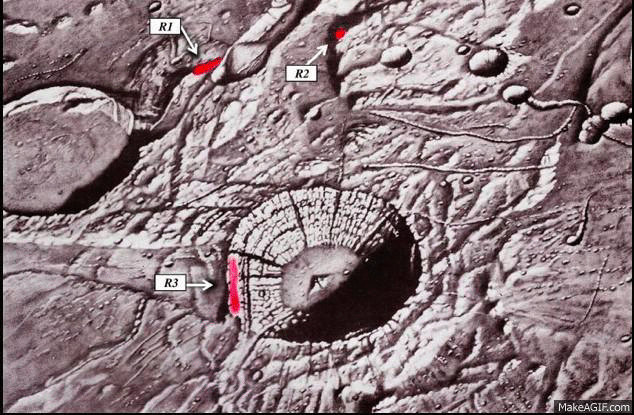September 9, 2023
50 Year Old Red Spots
Originally published August 25, 2013

LRO image and ACIC map animated gif by CAW
50 years ago this fall James Greenacre and Edward Barr observed three conspicuous red spots inside the rim of Aristarchus and near the Cobra-Head source of Schröter's Valley, and 3 hrs later a bluish glow around the northern rim of the crater. They were using the Lowell Observatory 24" Alvin Clark refractor. This is still considered the best evidence for a transient lunar phenomena or TLP. The observation has also been widely criticized as being made when the seeing was poor, with perhaps too high a magnification (500X), and with an achromatic telescope, so that atmospheric dispersion or chromatic aberration were advanced as likely explanations. Now Bob O'Connell and Tony Cook have performed a huge service by bringing together and evaluating virtually all documents related to this observation, including letters and telegrams not reported previously. Perhaps most importantly they also interviewed Greenacre's son and others with knowledge of Greenacre and the events. All this information is presented in an free article in the Journal of the British Astronomical Association with many primary documents in a companion website. Their documentation of Greenacre's career demonstrates that he was a well trained and experienced scientist who already had two years of observing with the 24" by the time the anomalous Aristarchus observations occurred. This new information about the scientific probity of Greenacre is the strongest evidence that the observation was a true anomalous event and less likely to be caused by dispersion or aberration. Bob and Tony also mention that LRO images do not seem to show evidence for any recent deposits that might be associated with the event. I confirm their conclusion, having searched the hyper-resolution LRO NAC images at the sites of the three red spots and around the northern rim of Aristarchus. There are various veneers of dark material but all contain numerous small craters that attest to the deposits being considerably more than 50 years old. If some physical event on the Moon did cause the TLP it left no detectable deposit. So it was less likely to be a lava flow or ash eruption than escape of gases. Four different events scattered across tens of kilometers seems unlikely, although an ad hoc explanation can be invented. Additionally the Lowell folks saw another TLP at Aristarchus at about the same phase during the next lunation, which is suspiciously consistent with the TLPs being visible only at certain observing conditions - i.e., an artifact of lighting. But someone will argue that a monthly recurrence might be expected if gases only can escape during monthly periods of maximum tidal stresses. I have not seen reports that Lowell scientists looked for Aristarchus area TLPs in subsequent months, but the lack of reports implies that nothing anomalous was seen. In fact, 50 years later, we still don't know if the observations were of something on the Moon or at the observers end.
Chuck Wood
(In comparing the LRO image and the ACIC map it looks like the mappers tended to overinterpret barely seen detail.)
Related Links
21st Century Atlas chart 28.
Yesterday's LPOD: Leibnitz Mountains?
Tomorrow's LPOD: Goddess of the Night
COMMENTS?
Register, Log in, and join in the comments.



